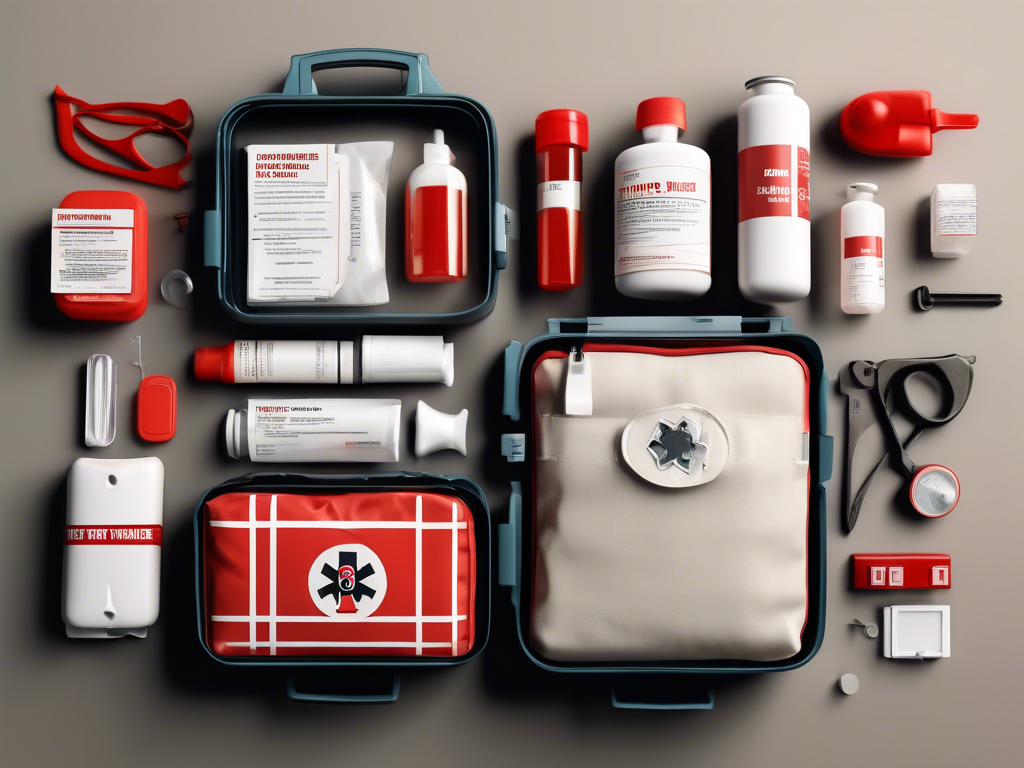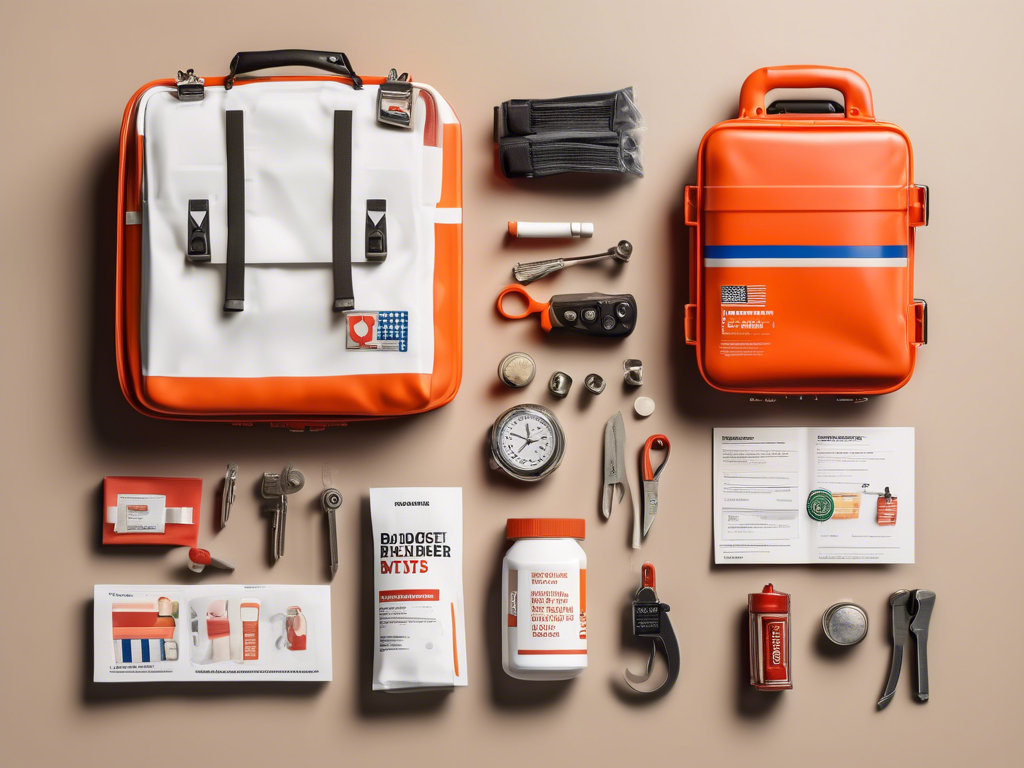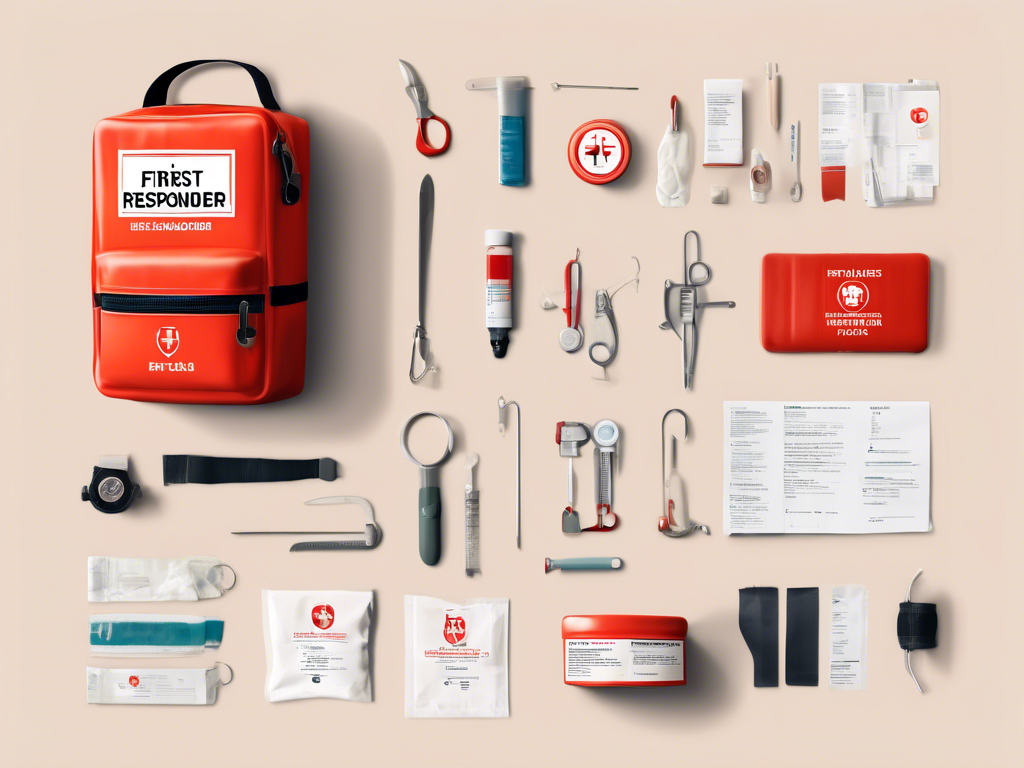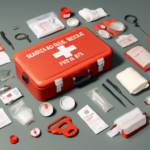In critical moments, every second counts, and having the right tools can mean the difference between life and death. First responders play a vital role in emergencies, often relying on their well-equipped first responder medical kits to provide immediate care. As we approach 2024, understanding the essentials of these kits is more important than ever. Whether you’re a seasoned professional or a volunteer, knowing what to include in your first responder trauma kit can significantly enhance your preparedness.
This guide delves into the essential features of effective first responder medical kits, helping you make informed choices when assembling or upgrading your own. From the fundamental supplies that should always be at hand to tips on how to customize your kit for specific situations, we leave no stone unturned. Additionally, we’ll discuss the importance of keeping these kits updated and how to train effectively for their use. Ultimately, our aim is to empower first responders by providing comprehensive insights and practical advice to ensure they are ready for any emergency.
Top Features to Look for in a First Responder Medical Kit

Comprehensive Supplies for All Emergencies
When selecting a first responder medical kit, it’s crucial to ensure that it includes a wide range of supplies. A well-rounded trauma kit should cover various emergencies, including cuts, burns, fractures, and severe bleeding. Look for kits that contain essential items such as:
– Adhesive bandages
– Sterile gauze pads
– Antiseptic wipes
– Trauma dressings
– Splints
Having these supplies readily available can make a significant difference in critical situations. 🩹
Durability and Portability
First responders often operate in unpredictable environments, making the durability of a medical kit paramount. Choose a first responder trauma kit designed with robust materials that can withstand harsh conditions. Additionally, portability is key—ensure the kit is lightweight and easy to carry, featuring handles or straps for quick access during emergency response. 🏃♂️
Clear Organization and Easy Access
A top-tier first responder medical kit must have clear organization to facilitate quick access to supplies. Look for kits with designated compartments, color-coded sections, or transparent pouches. This organization helps responders find the needed items swiftly, which is critical in life-threatening scenarios. Consider kits that include labeled first aid guides for additional support! 📖
Medical Equipment for Critical Care
In severe cases, having specialized medical equipment within your first responder medical kit can be a lifesaver. Essential tools might include:
– Tourniquets
– Hemostatic dressings
– Adult and pediatric BVMs (Bag-Valve-Masks)
– CPR masks
These items enable responders to provide immediate care and stabilize patients effectively before professional medical help arrives. 🚑
Customization Options
Every first responder has unique needs based on their operational environment. A customizable first responder trauma kit allows individuals or teams to tailor their medical supplies. Check if the kit provides options to add specific medications, additional dressings, or even personal protective equipment like gloves and masks. This personalization ensures readiness for various incidents! 🛡️
Building the Ultimate First Responder Trauma Kit: A Step-by-Step Guide

Assess Your Emergency Needs
Before you begin assembling your first responder trauma kit, it’s important to assess the specific emergency needs of your environment or team. Consider the types of incidents you are most likely to encounter, whether they be medical emergencies, natural disasters, or accidents. 🏥 For instance, if you frequently work in remote areas, include supplies for advanced wound care and environmental injuries like hypothermia.
Selecting Essential Supplies
Once you’ve assessed your needs, it’s time to select the essential supplies that will form the backbone of your first responder trauma kit. Here’s a recommended list to consider:
– **Basic first aid items**: Adhesive bandages, sterile gauze, antiseptic wipes.
– **Trauma supplies**: Trauma dressings, splints, and tourniquets.
– **Medication**: Over-the-counter pain relievers, antihistamines, and any personal medications required.
– **Specialty tools**: CPR masks and shears for cutting clothing or bandages.
By carefully choosing these items, you can ensure that your trauma kit is well-equipped for various emergencies. 🎒
Organizing for Quick Access
A critical aspect of a successful first responder trauma kit is its organization. Use clear, labeled compartments to separate different types of supplies, allowing for quick access during emergencies. 💨 Consider color-coding sections and including a small guide with instructions on how to use certain items. This organization can save vital seconds when every moment counts.
Regularly Check and Update Supplies
Creating a first responder trauma kit isn’t a one-time task; it requires regular maintenance. Schedule routine checks (e.g., quarterly) to inspect the contents of your kit. Look for expired medications, used supplies, or items that may need replenishing. 🔄 Keeping your kit stocked and up-to-date ensures you’re always prepared for any situation.
Training and Practice
Having a well-stocked first responder trauma kit is only part of the equation; training and practice are equally important. Ensure that all team members are familiar with the equipment and supplies available. Conduct regular drills to practice using the kit effectively in various scenarios. This preparation can significantly enhance response capabilities during real-life emergencies. 🧑⚕️
Consider Personalization
Lastly, don’t forget about personalization! Each first responder may have unique requirements based on their experiences. Customizing your first responder trauma kit can include adding specific medications or specialized equipment relevant to your field. Tailoring your kit not only increases efficiency but also boosts confidence among responders, knowing they have what they need. 🌟
Essential Supplies Every First Responder Medical Kit Should Have

Basic First Aid Essentials
Every first responder medical kit must include the fundamental supplies to address minor injuries effectively. Basic first aid essentials are crucial for managing a range of situations, from cuts and scrapes to abrasions. Ensure your kit contains:
– Adhesive bandages
– Sterile gauze pads
– Antiseptic wipes
– Non-stick dressings
These items form the foundation of any medical response and help stabilize patients until further medical treatment can be administered. 🩹
Trauma Management Supplies
In emergencies involving severe injuries, having effective trauma management supplies in your first responder trauma kit is essential. Be prepared for significant bleeding or trauma by including the following items:
– Trauma dressings
– Tourniquets
– Hemostatic agents
– Splints
These tools are critical for controlling hemorrhage and immobilizing fractures, enabling responders to provide immediate care during life-threatening situations. 🚑
Medical Equipment for Airway Management
Airway management is a vital aspect of emergency medicine. Including specialized equipment in your first responder medical kit can make a significant difference in critical scenarios. Essential items may include:
– CPR masks
– Bag-valve masks (BVM) for ventilation
– Oropharyngeal airways
– Nasopharyngeal airways
These devices allow first responders to maintain an open airway and ensure adequate breathing support until advanced medical assistance arrives. 🌬️
Medication for Emergency Situations
Having medications readily available can enhance the effectiveness of your first responder trauma kit. Consider adding the following over-the-counter and prescription medications:
– Pain relievers (e.g., ibuprofen, acetaminophen)
– Antihistamines for allergic reactions
– Aspirin for cardiac events
– Personal prescription medications if necessary
A well-stocked medication section can help manage various medical emergencies effectively, providing immediate relief to patients. 💊
Comfort and Safety Items
In addition to medical supplies, your first responder medical kit should also include comfort and safety items to protect both responders and patients. Important additions include:
– Nitrile gloves for infection control
– Face shields or masks
– Thermal blankets to prevent hypothermia
– Backboards for spinal immobilization
These supplies not only enhance safety during interventions but also improve the overall experience for patients receiving care. 🛡️
How to Customize Your First Responder Trauma Kit for Specific Emergencies

Identify Common Emergency Scenarios
To effectively customize your first responder trauma kit, start by identifying the most common emergency scenarios you may encounter in your environment. This could include scenarios such as vehicle accidents, industrial incidents, or disasters like floods and earthquakes. 🍃 By understanding the typical emergencies, you can tailor your supplies to meet specific needs, ensuring you’re well-prepared when critical situations arise.
Assess Potential Hazards and Risks
Consider the unique hazards associated with your operational area. Are there frequent wildlife encounters that necessitate snake bite kits? Is your team likely to respond to hazardous material spills that require specialized protective gear? 🦺 Assessing these risks will guide you in selecting items for your first responder trauma kit that address potential threats effectively. Making calculated additions to your kit can significantly enhance your preparedness.
Include Specialty Items for Unique Situations
Depending on your assessment of risks, it’s wise to include specialty items tailored for specific emergencies. Examples of these specialty items are:
– **Snake bite kits** for rural areas.
– **Burn care products** for fire-related incidents.
– **Environmental injury supplies** (e.g., thermal blankets for hypothermia).
– **Chemical exposure antidotes** if the risk of hazardous materials exists.
Adding these specialized supplies to your first responder trauma kit can be crucial for addressing specific incidents and enhancing the safety of both responders and victims. 🧯
Regular Updates Based on Season or Region
Seasonal changes can impact the types of emergencies your team may face. For example, warmer months may result in more heat-related illnesses, while winter could bring snow-related injuries. Thus, regularly update your first responder trauma kit based on the current season or any geographic challenges. ❄️🌞 Consider adding or replenishing supplies like electrolyte packets for heat exhaustion in summer or additional layers for cold weather injuries in winter.
Collaborate with Team Members
Customization should also involve input from all team members who will use the first responder trauma kit. Conduct a brainstorming session to gather insights about additional supplies or equipment they feel would be beneficial. Encourage open communication about past experiences during responses, which can shed light on supply gaps or new needs. 🤝 This collaborative approach not only boosts morale but ensures that everyone is equipped with the necessary tools to save lives.
The Importance of Regularly Updating Your First Responder Medical Kit

Ensuring Readiness for Emergencies
Regularly updating your first responder medical kit is critical to ensure readiness in emergency situations. As supplies can degrade or expire, keeping your kit stocked with fresh items directly influences your ability to provide timely and effective care. By conducting routine checks, you can confirm that medical supplies, medications, and equipment are in optimal condition and ready for use when the need arises. 🚨
Replacing Expired Supplies
One of the primary tasks when updating your first responder trauma kit is to check for expired items. Medications and sterile supplies, such as bandages and antiseptics, can lose their effectiveness over time. Here’s a checklist to help you assess your kit:
– **Check expiration dates** on all medications.
– **Inspect sterile packaging** for integrity.
– **Replace any used items**, such as gauze pads or dressings.
By maintaining fresh supplies, you not only comply with safety standards but also enhance your readiness for critical responses. 📅
Adapting to Changing Needs
Over time, the types of emergencies you might encounter can evolve based on factors such as location, season, and community needs. Regular updates to your first responder medical kit allow you to adapt to these changes effectively. For instance, if you begin to face more incidents related to outdoor activities during warmer months, consider adding items specific to environmental injuries, like insect bite kits or hydration solutions. 🌳
Training and Familiarization
Updating your first responder trauma kit isn’t solely about replacing materials; it also presents an opportunity for training and familiarization with new supplies. Whenever you introduce new items into the kit, conduct training sessions for your team. This ensures that everyone is aware of the available resources and confident in using them during emergencies. Engaging in periodic drills can also enhance your team’s overall preparedness! 🏋️♀️
Creating a Maintenance Schedule
Establishing a maintenance schedule for your first responder medical kit is an excellent way to ensure you stay on top of updates. Consider implementing quarterly reviews where you assess supplies, educate team members about any changes, and restock as necessary. Using a checklist can simplify this process, making it easier to track what needs replenishing or replacing. 📋
Incorporating Feedback and Lessons Learned
Finally, regularly updating your kit should involve gathering feedback from team members about past experiences and lessons learned from real-life incidents. Discuss what worked well and what could have been improved during responses. This collaborative approach not only helps identify supply gaps but also fosters a culture of continuous improvement among first responders. Together, you can build a more efficient and comprehensive first responder medical kit. 🤝
Comparing Popular First Responder Medical Kits: Which One is Right for You?

Understanding Different Kit Types
When evaluating first responder medical kits, it’s important to recognize the various types available. Typically, these kits can be categorized into general first aid kits, specialized trauma kits, and tactical kits. Each type serves a distinct purpose:
– **General First Aid Kits**: Ideal for everyday minor injuries, containing basic supplies like band-aids and antiseptics. 🩹
– **Trauma Kits**: More comprehensive, designed specifically for severe injuries, including tourniquets and hemostatic dressings. 🚑
– **Tactical Kits**: Tailored for professionals in combat or high-stress environments, often featuring durable materials and advanced medical equipment.
Selecting the right kit depends on your specific needs and the scenarios you frequently encounter.
Feature Comparison: What to Look For
Not all first responder trauma kits are created equal. When comparing kits, consider features such as:
– **Size and Portability**: Is the kit easily transportable? Opt for lightweight options with handles.
– **Durability**: Look for kits made from rugged materials that can withstand harsh conditions.
– **Organization**: Check if the supplies are well-organized for quick access in emergencies.
– **Medical Equipment**: Finalize whether the kit includes essential tools like CPR masks and splints.
Assessing these features will help ensure you choose a kit that meets your operational requirements effectively. 📦
Top Brands and Their Offerings
Several reputable brands manufacture high-quality first responder medical kits. Here are a few top contenders:
– **Everlit**: Renowned for their comprehensive trauma kits which include all essential items for emergency response.
– **My Medic**: Offers customizable kits that allow users to add or remove items based on personal needs.
– **Lifeline**: Provides compact kits perfect for outdoor enthusiasts who need portable yet effective solutions for emergencies.
Researching these brands can guide you in selecting a kit that suits your preferences and requirements. 🌟
Cost vs. Quality: Finding Your Balance
Price is often a significant factor when choosing a first responder trauma kit. However, it’s vital to balance cost with quality. While cheaper kits may seem appealing, they often lack essential supplies or durability. Consider investing in a mid-range to high-quality kit to ensure reliability in emergencies. Always read reviews and compare the costs of similar items to find the best value for your needs. 💰
Customization for Specialized Needs
Many responders have unique requirements based on their environment or role. Customizing your first responder medical kit can enhance its effectiveness. Consider adding:
– **Special medications**: Tailor your kit with essential prescriptions or specific over-the-counter medications.
– **Additional tools**: Depending on your location, consider adding items like an epinephrine auto-injector for allergic reactions. 🩺
– **Personal protective equipment**: Ensure you are equipped with gloves and masks for safety when dealing with potential infections.
By customizing your kit, you can ensure optimal readiness for any situation you might face. 🔧
Training Tips for Using Your First Responder Trauma Kit Effectively

Understand Your Kit’s Contents
Familiarity with the supplies in your first responder trauma kit is crucial for effective use in emergencies. Take time to go through each item and understand its purpose. Make a checklist of the contents and become proficient in identifying them quickly during high-pressure situations. This knowledge empowers responders to act decisively and efficiently, ultimately saving precious time when lives are on the line. 📋
Conduct Regular Training Drills
Implementing regular training drills is vital for all team members who will utilize the first responder medical kit. Simulate various emergency scenarios to practice using the items within the kit effectively. Encourage team members to rotate roles during these drills to ensure everyone is comfortable handling different responsibilities. Regular exposure to real-life situations helps build confidence and proficiency, enabling better response capabilities when it truly matters. 🚨
Utilize Visual Aids
Incorporating visual aids in your training sessions can significantly enhance understanding and efficiency. Create labeled diagrams of the kit’s contents, including pictures or instructions on how to use specific supplies properly. Consider placing this information inside the kit or in a visible area during training drills. Visual aids cater to diverse learning styles and ensure that everyone can grasp essential skills quickly and effectively. 📖
Provide Ongoing Education
Stay updated with the latest first aid techniques and protocols by providing ongoing education to your team. Host workshops and invite qualified instructors to teach specialized skills related to the use of the first responder trauma kit. Encourage team members to pursue first aid certifications to build their expertise further. Keeping skills sharp fosters a culture of continuous improvement and readiness among responders. 💡
Evaluate and Adjust Training Methods
After conducting training sessions, take the time to evaluate their effectiveness. Gather feedback from team members about what worked well and what could be improved. Use this input to adapt your training methods and materials to ensure they meet the needs of your responders. Continuous refinement of training processes not only maximizes preparedness but also boosts team morale and confidence in using the first responder trauma kit. 🔄
Essential Accessories for Enhancing Your First Responder Medical Kit

Advanced Wound Care Supplies
In addition to the basics, including advanced wound care supplies in your first responder medical kit can dramatically improve patient outcomes. Consider incorporating items like hydrocolloid dressings and burn gel. These specialized products help in managing severe wounds and burns effectively. By having such supplies readily available, you enable more comprehensive treatment options during critical situations. 🩹
High-Visibility Gear
Visibility is crucial when responding to emergencies, especially in low-light conditions or high-traffic areas. Equipping your first responder trauma kit with high-visibility gear, such as reflective vests and LED flashlights, helps ensure that responders are easily seen and safe while attending to patients. This addition not only enhances safety but also promotes a professional appearance during emergency responses. 🌟
Communication Devices
Effective communication is key in any emergency situation. Including portable radios or signaling devices in your first responder medical kit ensures that responders can maintain contact with their team and call for additional help when necessary. Having reliable communication tools can make all the difference in coordinating efforts and securing timely assistance for the affected individuals. 📞
Additional Personal Protective Equipment (PPE)
Safety is paramount for first responders. Alongside standard gloves, consider adding a variety of Personal Protective Equipment (PPE) to your first responder trauma kit, such as goggles, face masks, and gowns. These items protect responders from bloodborne pathogens and hazardous materials, ensuring a safer environment while providing care. 🛡️
Coping and Comfort Items
Finally, don’t forget about the mental well-being of both responders and patients. Including coping items, such as stress balls or comforting notes, can aid in managing anxiety during traumatic incidents. Furthermore, having items like thermal blankets can provide warmth and comfort to patients in distress. By addressing both physical and emotional needs, your first responder medical kit can become a more holistic resource during emergencies. 💖
Budget-Friendly Options for Comprehensive First Responder Kits

Affordable Pre-Packaged Kits
When searching for budget-friendly options, consider pre-packaged first responder medical kits. These kits often provide a comprehensive range of supplies at a lower cost than purchasing individual items separately. Retailers typically offer various sizes to fit different needs—ranging from basic first aid kits to more specialized trauma kits suited for severe injuries. By investing in a reputable pre-packaged kit, you can ensure that essential supplies are included without exceeding your budget. 💸
DIY First Responder Trauma Kit
Creating your own first responder trauma kit can be a cost-effective alternative. Many everyday items can serve as crucial components, and customizing the kit allows you to tailor it to your specific needs. Here’s a list of affordable items to consider including:
– Adhesive bandages
– Sterile gauze pads
– Antiseptic wipes
– Trauma dressings
– Disposable gloves
This DIY approach not only saves money but also empowers you to select exactly what you require for various emergency situations! 🛠️
Utilizing Discounts and Bulk Purchases
Many suppliers offer discounts for bulk orders, which can significantly reduce the overall cost of assembling your first responder medical kit. Purchasing items in larger quantities often results in lower prices per unit. Additionally, keep an eye out for seasonal sales or coupon codes from reputable online stores. By planning your purchases strategically, you can build a complete, high-quality trauma kit while staying within your budget. 📦
Community Fundraising Initiatives
If you’re part of a service organization or volunteer group, consider organizing community fundraising initiatives to raise funds for your first responder medical kit. Activities such as bake sales, car washes, or local events can engage your community while collecting necessary finances. This collaborative effort not only enhances your kit but fosters a sense of teamwork and shared responsibility among members. 🤝
Second-hand Equipment and Supplies
Don’t overlook the possibility of sourcing first responder supplies from second-hand listings or surplus inventories. Many organizations upgrade their gear and sell older, yet still functional items at reduced prices. Websites and local auctions can be great places to find quality supplies without breaking the bank. Just ensure that any used equipment you acquire is in good condition and suitable for your needs. 🛒
Online Resources and Grants
Finally, explore online resources that provide information about grants and funding opportunities specifically designed for first responders. Various organizations and community foundations offer financial support for acquiring essential equipment like first responder medical kits. Researching these options could lead to significant savings, making it easier to equip yourself effectively for emergencies! 🌐
Summing up
As we wrap up our exploration of first responder medical kits, it becomes clear that preparation and knowledge are two of the most vital components for effective emergency response. We have covered numerous elements, from the top features to look for to how to customize your kit for various emergencies. It’s essential to remember that maintaining a well-stocked and updated first responder trauma kit can save lives and facilitate optimal care during crisis situations.
Regularly evaluating the contents of your kit ensures that you are not only compliant with current standards but also ready for unexpected scenarios. Training and familiarization with your kit’s features and supplies can further enhance your effectiveness during emergencies. With so many budget-friendly options available today, there’s no reason to compromise on quality or preparedness.
As you head into 2024, take stock of your first responder medical kit and consider making improvements where necessary. By doing so, you invest not only in your safety but also in the health and wellbeing of those you serve. Remember, being prepared is not just about having the right tools; it’s about ensuring you have the confidence and knowledge to use them effectively when it matters most. So gear up and get ready—your next emergency could be just around the corner.



